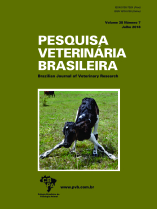 |
|
|
|
Year 2018 - Volume 38, Number 7
|

|
Closed suction drain in total unilateral mastectomy in bitches, 38(7):1412-1422
|
ABSTRACT.- Freccia C., Dallabrida A.L., Costa Á., Regalin B.D.C., Comassetto F., Cardoso H.M., Antonelli M. & Oleskovicz N. 2018. [Closed suction drain in total unilateral mastectomy in bitches.] Dreno de sucção fechado em mastectomias unilaterais totais em cadelas. Pesquisa Veterinária Brasileira 38(7):1412-1422. Programa de Pós-Graduação em Ciência Animal, Universidade do Estado de Santa Catarina, Av. Luiz de Camões 2090, Conta Dinheiro, Lages, SC 88520-000, Brazil. E-mail: carinafreccia@hotmail.com
The aim of this study was to evaluate the use of closed suction drain in surgical wounds of total unilateral mastectomy in dogs. Eighteen dogs were used with an average weight of 14.87±9.29kg, average age 9.34±2.68 years, from the hospital routine, which were selected through clinical and oncological evaluation. The animals were divided into two groups: Conventional (CG, n=9) which underwent total unilateral mastectomy surgery without drain and Drain group (DG, n=9) which underwent complete unilateral mastectomy with placement closed suction drain (Biovácuo). The diameter of the drain was determined according to the animal weight. Five evaluations were performed during the postoperative period: clinical evaluation of the animals daily through the heart rate (HR), respiratory rate (RR), rectal temperature (RT), color of mucous membranes, capillary refill time (CRT), degree of dehydration, blood count, chemistry profile (urea, creatinine, cholesterol, triglycerides and glucose); qualitative assessment of the drain; qualitative assessment of the surgical wound, is also being held on 14 and 30 days for the presence or absence of exudate, edema, skin integrity, dehiscence, necrosis and scarring; quantitative evaluation of the drained fluid; qualitative assessment of fluid drained, as the cellularity type and cell morphology. Surgical time was recorded in both groups. There were an increase in average values of density, neutrophils, lymphocytes, and increased fibrinogen median value of drained fluid in 72 hours compared to 24 hours in DG group. There was an increase of exudate within 24, 48 and 72 hours in DG when compared to GC. There was an increase in the volume of drained fluid in 60 and 72 hours compared to 12 hours in DG. There was a reduction in the average value of red blood cells within 72 hours from baseline in DG group. There was an increase in average hemoglobin and hematocrit in 24 hours in the control group compared to the DG. There was an increase in the average value of neutrophils targeted at baseline in DG when compared to CG. It follows that, the closed suction drain placement technique presents more exudate. It is recommended that the drain vacuum is redone 12 in 12 hours, initially being performed 6 hours after surgery. The closed suction drain does not generate additional discomfort to the patient; it is recommended that it be removed 72 hours after the surgery, when the fluid production decreases, but even so some individuals may present seroma formation in the late postoperative. |
| |
|
|
| |
|
 |